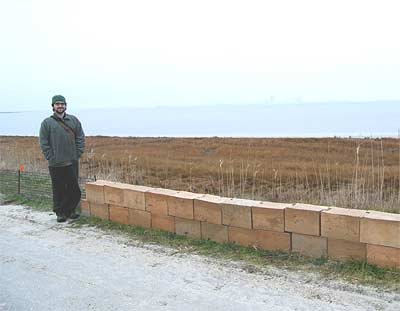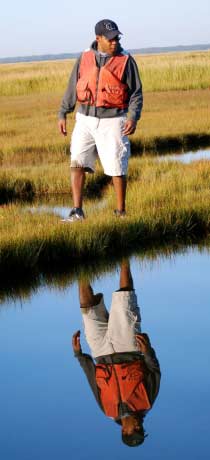 |
Abstracts of Papers
Presented by Wetlands Institute staff at the
Atlantic Estuarine Research Society Fall 2008 Meeting,
George Mason University, Fairfax, VA, November 6–8, 2008
Use of Road Barriers to Reduce the Impacts of Vehicle Strikes
on Diamondback Terrapins (Malaclemys terrapin terrapin) in Southern New Jersey.
Illene S. Eberly

The Wetlands Institute, 1075 Stone Harbor Boulevard, Stone Harbor, NJ 08247, USA
 |


Barrier constructed from “Terrapin blocks” |
|
 |
Coastal development on barrier beach islands along the Cape May Peninsula has eliminated access to and/or destroyed dune systems that originally served as the primary nesting habitat for diamondback terrapins (Malaclemys terrapin). Female terrapins have, therefore, found alternate nesting grounds along embankments of causeways adjacent to marshes. As a result, each summer from late May to mid-July, thousands of gravid diamondback terrapins are struck by motor vehicles. During the breeding seasons of 2004–2008, barrier fencing was installed along heavily trafficked causeways, resulting in 84–100% reduction of terrapin mortality. During the 2006 nesting season, we installed a 0.3 km section of fencing material, “Tenax” (a thick, mesh material), to test its durability in harsh coastal conditions over the course of a year. Initial results from those tests suggest that Tenax fencing is durable enough for year-round use. However, the installation of Tenax fences is complex, labor-intensive, and requires frequent maintenance. We are currently investigating the use of “terrapin blocks,” (similar to cinder blocks) manufactured with 40% dredge material, as a barrier. The terrapin blocks were developed by Continental Aggregates Corp LLC in support of a NJ Department of Transportation grant project, “The Innovative Use of Dredged Materials and Disposal Sites to Reduce Diamondback Terrapin Mortality & Enhance Nesting Habitats.” Although the blocks were installed after the 2008 nesting season, we found that installation was much less labor intensive. Therefore, while we can recommend the use of terrapin barriers as an effective means of reducing vehicle-related mortality in nesting female terrapins, further research is required to determine the ideal fence material.
 |


Phillip Skipwith searches for terrapins in a salt marsh pannes. |
|
Northern Diamondback Terrapin (Malaclemys terrapin terrapin)
Habitat Use of Salt Pannes in a New Jersey Salt Marsh
Phillip Skipwith, Patrick Baker, and Roger Wood

The Wetlands Institute, 1075 Stone Harbor Boulevard, Stone Harbor, NJ 08247, USA
The northern diamondback terrapin, Malaclemys terrapin terrapin, is a brackish water species that inhabits tidal creeks, shallow bays, and adjacent upland habitats of the salt marsh. Within upland marsh habitats are ponds, known as salt marsh pannes, that are inundated during extreme high tides. However, little is known about terrapin use of salt pannes in Cape May Pensisula. A mark-recapture study was initiated to better understand terrapin occurrence and population structure in salt pannes. Over three years, 114 terrapins were captured in 20 pannes. Terrapin populations within pannes were female-biased with females accounting for 58–69% of captures; however, 4 pannes had male-biased sex ratios in some years. Juvenile and adult females (10.1–19.3 cm, n = 72) and adult males (10.3–13.4 cm, n = 42) were captured, but no hatchlings of either sex or juvenile males. Of 12 recaptures, 9 terrapins were captured in the same panne in subsequent years, indicating high site fidelity for some individuals. These findings suggest that salt pannes are an important component to understanding juvenile and adult M. t. terrapin ecology.
Return to Abstracts Index
|
 |
![]()
![]()

